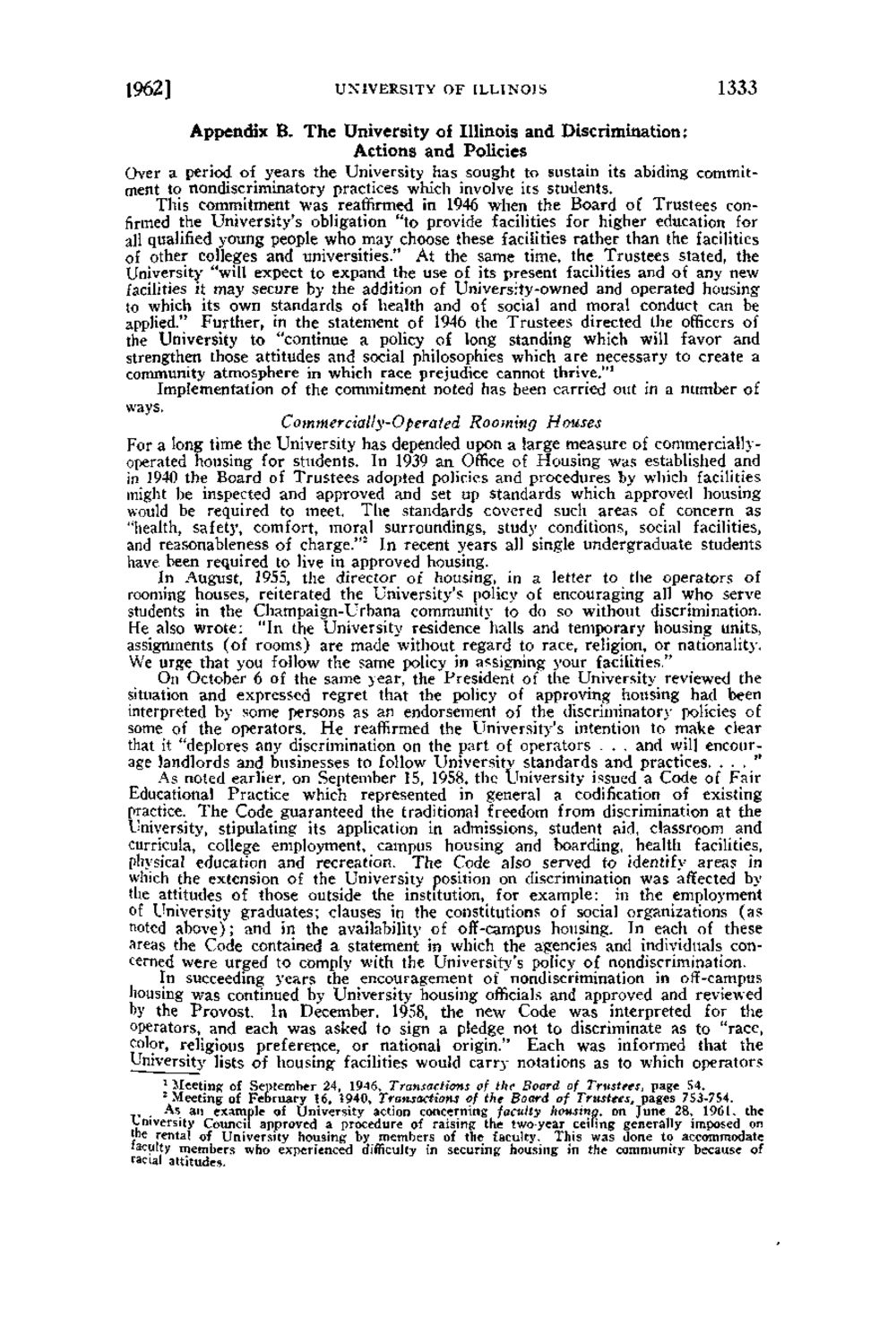| |
| |
Caption: Board of Trustees Minutes - 1962
This is a reduced-resolution page image for fast online browsing.

EXTRACTED TEXT FROM PAGE:
1962] UNIVERSITY OF I L L I N O I S 1333 Appendix B. The University of Illinois and Discrimination: Actions and Policies Over a period of years the University has sought to sustain its abiding commitment to nondiscriminatory practices which involve its students. This commitment was reaffirmed in 1946 when the Board of Trustees confirmed the University's obligation "to provide facilities for higher education for all qualified young people who may choose these facilities rather than the facilities of other colleges and universities." At the same time, the Trustees stated, the University "will expect to expand the use of its present facilities and of any new facilities it may secure by the addition of University-owned and operated housing to which its own standards of health and of social and moral conduct can be applied." Further, in the statement of 1946 the Trustees directed the officers of the University to "continue a policy of long standing which will favor and strengthen those attitudes and social philosophies which are necessary to create a community atmosphere in which race prejudice cannot thrive.'" Implementation of the commitment noted has been carried out in a number of ways. Commercially-Operated Rooming Houses For a long time the University has depended upon a large measure of commerciallyoperated housing for students. In 1939 an Office of Housing was established and in 1940 the Board of Trustees adopted policies and procedures by which facilities might be inspected and approved and set up standards which approved housing would be required to meet. The standards covered such areas of concern as "health, safety, comfort, moral surroundings, study conditions, social facilities, and reasonableness of charge." 2 In recent years all single undergraduate students have been required to live in approved housing. In August, 1955, the director of housing, in a letter to the operators of rooming houses, reiterated the University's policy of encouraging all who serve students in the Champaign-Urbana community to do so without discrimination. He also wrote: "In the University residence halls and temporary housing units, assignments (of rooms) are made without regard to race, religion, or nationality. We urge that you follow the same policy in assigning your facilities." On October 6 of the same year, the President of the University reviewed the situation and expressed regret that the policy of approving housing had been interpreted by some persons as an endorsement of the discriminatory policies of some of the operators. He reaffirmed the University's intention to make clear that it "deplores any discrimination on the part of operators . . . and will encourage landlords and businesses to follow University standards and practices. . . . " As noted earlier, on September 15, 1958, the University issued a Code of Fair Educational Practice which represented in general a codification of existing practice. The Code guaranteed the traditional freedom from discrimination at the University, stipulating its application in admissions, student aid, classroom and curricula, college employment, campus housing and boarding, health facilities, physical education and recreation. The Code also served to identify areas in which the extension of the University position on discrimination was affected by the attitudes of those outside the institution, for example: in the employment of University graduates; clauses in the constitutions of social organizations (as noted above); and in the availability of off-campus housing. In each of these areas the Code contained a statement in which the agencies and individuals concerned were urged to comply with the University's policy of nondiscrimination. In succeeding years the encouragement of nondiscrimination in off-campus housing was continued by University housing officials and approved and reviewed by the Provost. In December, 1958, the new Code was interpreted for the operators, and each was asked to sign a pledge not to discriminate as to "race, color, religious preference, or national origin." Each was informed that the University lists of housing facilities would carry notations as to which operators Meeting of September 24, 1946, Transactions of the Board of Trustees, page 54. Meeting of February 16, 1940, Transactions of the Board of Trustees, pages 753-754. As an example of University action concerning faculty housing, on June 28, 1961. the tniversity Council approved a procedure of raising the two-year ceiling generally imposed on the rental of University housing by members of the faculty. This was done to accommodate faculty members who experienced difficulty in securing housing in the community because of racial attitudes. 1 2
| |